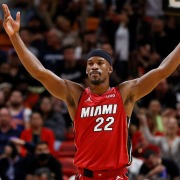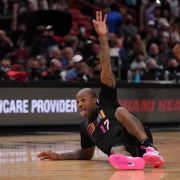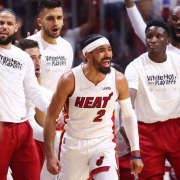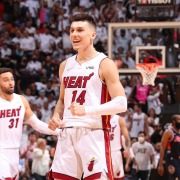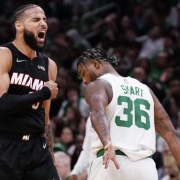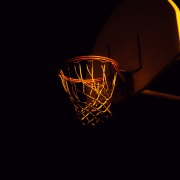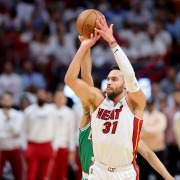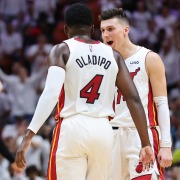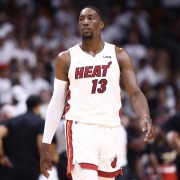Jimmy Butler: His Area of Expansion this Season
This Heat off-season, when viewing from the outside, has had a very clear theme to it: 1) making the necessary improvements internally within the roster, which I’ve been addressing throughout this article series, and 2) building correctly around the captain of the ship, Jimmy Butler.
After watching what he has been able to do 2 out of the last 3 years in the playoffs, it puts a lot of things in perspective when viewing this roster. But the key point to make is that Playoff Jimmy won’t get going until April, so how can he sustain his play over the next few months of a pretty crucial regular season in the packed East.
We all know his play-style varies from regular season to playoffs, but there are a few things that can be just as effective in both. It’s all about sustaining both high level play and health. Not putting too much stress on him in the first 82, since it seems that’s always what ends up happening once the “real season” begins.
Looking into his game a bit more, it’s not like other guys where we’re awaiting certain jumps in their offensive game. For veterans like Butler, it’s more about tweaking role and volume to maximize them within a system.
Speaking of that exactly, there’s one part of his game that deserves a deeper discussion, since I believe it’s utilized more than ever this upcoming season: Jimmy Butler as the roll man.
Everybody knows what he can do as an on-ball threat and pick and roll ball-handler, but this roster is absolutely full of that same exact build. Guys like Kyle Lowry, Tyler Herro, Victor Oladipo, and hopefully Bam Adebayo will need to have decent usage to be effective in their respective roles. And while it’s clear Butler will be high on that list as well, there’s also the part of this where they can shift him into different spots to be just as effective.
Butler scored 1.29 points per possession this past season as the roll man, while shooting 54% on those reps. To elevate this point even more, that mark jumped up to 1.75 points per possession in the post-season on 78% shooting.
Just an insane number.
Of course this isn’t on the same volume of the average big man, but his efficiency and effectiveness on the short roll opens up so much for him as a scorer.
The first level to utilizing him within this play-style is shown in the clips above. Simple pick and rolls, most of the time being mirrored with Kyle Lowry. It was a combo that almost guaranteed a Butler bucket at the rim. Screen, slip, float pass, lay-in. It’s a hard set to guard if the defense respects Lowry’s pull-up 3 enough, which will be a critical part of this season.
Aside from that, it creates mismatch heaven for Butler, which as seen in the first clip above, almost always ends in a post-up with Butler punishing. This is right in his wheelhouse, simultaneously representing the reasoning we saw that uptick for him in the playoffs. Teams like the Hawks could not make up for the hunting that Butler could provide.
But the reason I bring up this entire topic is that it can be branched out immensely. It’s not as simple as running pick and roll after pick and roll with him, since there’s no fluidity or diversity there. Instead, it’s the fact it can be maximized within so many of their base sets already.
After losing PJ Tucker this off-season, a specific element they lost that isn’t being talked about much is the screening decline. Tucker was probably the best overall screener on the team, really doing damage off the ball.
To bounce off of that, Butler will see an increase in that department as wild as that may sound. Not to be taking a toll on his body, but instead to create chaos with slipping, hand-offs, and more. As seen above, it’s just an initiator of movement for guys like Herro to flow off the DHO for pull-up looks.
We often bring up the word “gravity” when addressing the shooters on the floor, but do you know who is a direct definition of that word? Jimmy Butler.
The difference is that he has interior gravity even at his size. If you’ve ever watched the way defenses guard him off the attack with the ball or not, it expands the court with the collapse that follows.
Plus if his hot shooting carries over from the playoffs/off-season, a little pick and pop off these hand-offs could go a long way.
The point of all of this is finding a sound and comfortable role for Butler to be effective within the possessions that Herro and/or Oladipo are dominating the ball. Butler always enjoys being more of a play-maker during that time of year anyway, and this is a way for Miami to bridge that gap with a passer off the roll that isn’t named Bam Adebayo.
To continue through the different options they have with him in this area, I must reiterate a point I’ve been bringing up in any article or podcast you may have read or heard from me: the Miami Heat should be expanding their motion offense.
More guards, more creators, more offensive threats. This is a team that falls right into that category of non-stop movement in the half-court, since they have all 3 elements necessary: high level play-makers, spot-up shooters, and multiple shot creators.
The reason I tie Butler into this as a roller can be seen in the clip above. Bam orchestrating, Herro and Robinson moving, Butler screening and slipping. It’s clockwork, since you simply cannot prepare for that slip to come when there’s chaos with the offensive threats on the back-side.
This team’s motion actions always look better when Butler is the receiver than when he is the quarterback. That has nothing to do with his passing ability, but instead Bam drawing out the opposing big opens up the possibility of opportunities at the rim.
And speaking of Bam drawing out that big, my last point within this new look adjustment consists of just that…
This play right here is Miami Heat art.
Bam above the break running an inverted PnR, Butler as the angled screener, and a perfect feed and roll for the eventual bucket. That right there is the picture perfect set for this offense.
Why is that? Well, other than the fact you’d like your two best players to be able to spam two-man game anyway, this set working consistently takes this entire Heat offense to new levels.
When talking about Bam, the main thing we call for is finding ways that he can flow downhill with the ball in his hands. With that said, inverted PnR’s are always the area we come back to, since it creates mismatches while putting Bam in a spot he feels comfortable.
The second part of this is everything I’ve discussed in this entire article. Butler as the screener/roller for him can hypothetically be the blend each of them are looking for, instead of the repetitive Butler-Bam PnR’s that connected on less points per possession (1.03 PPP) than the Butler-Dedmon combo (1.10 PPP) and the Butler-Yurtseven combo (1.22 PPP).
Yes, a lot of this stuff isn’t much of a change from what we’re used to, since they’ve ran a lot of this stuff before. But the main point here is increasing the frequency of it. Of course Butler’s on-ball usage won’t be declining, but it’s just about shifting things to maximize the lineups around him.
And as I said before, it can simultaneously be less physical stress for him in certain pockets of the game.
Jimmy Butler is always going to be Jimmy Butler, so don’t expect much change from him. But this minor adjustment could change how effective certain lineups look with multiple creators. (For example, the Lowry-Herro-Oladipo-Butler-Adebayo lineup.)
For the best daily fantasy props, and to double your deposit, use our code “five” at PrizePicks.com
